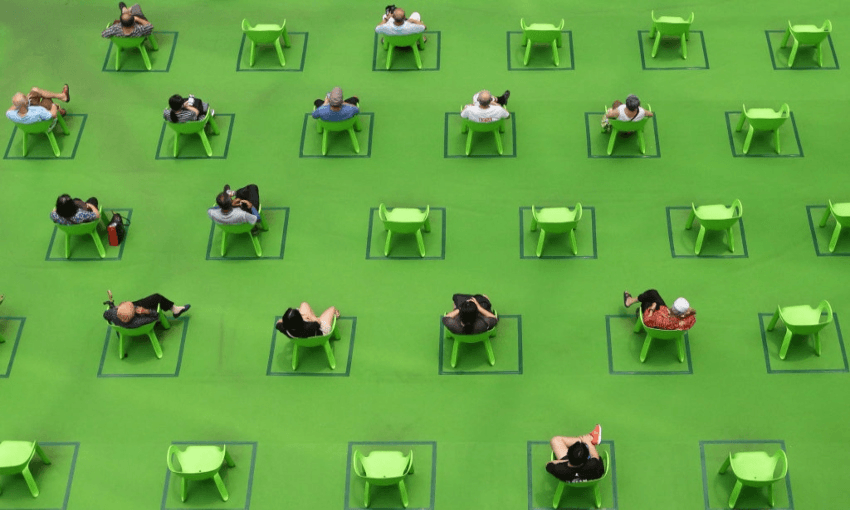Singapore has been widely cited as an example to follow in emerging from Covid lockdowns. But it’s important we don’t draw the wrong lessons, writes economist Rosie Collins.
Opening up won’t be as easy as we think – just look at Singapore.
Like New Zealand, Singapore has not let the virus run rampant and kept a low tolerance for deaths. As the island nation of about 5.5 million people begins to open, there have been breathless suggestions that Aotearoa should follow suit, and in haste.
But let’s pause and look at the numbers. Singapore’s partial opening led to over 26,000 cases and 38 deaths in September. Fearing health system chaos, they slapped on domestic restrictions – similar to a New Zealand level 2.5. High vaccination rates have kept most cases mild. Widespread rapid antigen testing, community-based care, and health capacity-based restrictions show us how we may follow.
Living with the virus will mean living with more restrictions – there is no going back to 2019; there is no going back to level one. These are myths.
What’s happening in Singapore
Singapore eased restrictions from early-August; after more than 70% of the population was partially vaccinated.
But it was not like our level one between lockdowns – more like 2.5. Gyms, restaurants, and bars reopened, and public gatherings were limited to groups of no more than five. Borders eased to let vaccinated travellers from low-risk countries skip quarantine or isolate at their choice of location.
Despite restrictions delta spread much faster than officials expected. Cases climbed from 70 a day in early August to over 2,000 a day in late September.
High vaccination meant 98% of cases were mild or without symptoms. But the sheer case volumes pressured hospitals. At the end of September, 238 people were on ventilators, using nearly a quarter of the country’s 1000-bed surge capacity.
To curb the exponential rise, Singapore tightened restrictions again last week. Group sizes for most public activities have now dropped further, to two people, household guests are limited to two a day, work from home is the default, and there are capacity limits on public spaces like malls and libraries.
If Auckland were Singapore
If Singapore’s experience was replicated in Auckland, over six weeks the city would face 7,400 new cases and 12 deaths. At the end of six weeks there would be 70 on ventilators, using a third (36%) of Auckland’s ventilator capacity. This doesn’t even account for very uneven vaccine rollout across Auckland (and New Zealand).
Singapore reimposed restrictions when health capacity was pressured. Germany also has a rules-based approach – using up 10% of ICU capacity in a day triggers strict domestic and border restrictions. We would reach this point sooner because we have less health capacity. Singapore has 50% more ICU beds than Auckland per person, and Germany has more than double.
The unvaccinated are most likely to need hospitalisation. But when health capacity is exhausted, the vaccinated majority will not get timely care. Emergency care will be restricted, and elective care will be rationed. The cost is societal.
Living in the in-between
Singapore did not throw caution to the wind and remove all restrictions. It reduced restrictions cautiously, and their health system came under pressure despite a highly vaccinated population.
There are some important lessons for us in New Zealand. First, vaccination helps. The majority of Covid cases are mild or asymptomatic.
Second, scared people will flock to the hospital. Singapore now has guidance for home-based care and telehealth access. We will need to create a similar approach.
Third, widespread rapid antigen testing is giving officials timely intelligence. Each household in Singapore received six home-test kits this month, and there are test-kit vending machines to support regular self-testing. We need to urgently introduce rapid antigen testing and make it widely available. This is complementary to, rather than instead of, existing PCR testing.
Fourth, restrictions are a policy choice, but there’s no credible scenario yet of zero restrictions. We can choose which restrictions and when.
We can relax the border, but the cost is other domestic restrictions, such as regular testing, vaccine-only access to many events and locations, and group size limits in public places.
Even with 80% of New Zealand’s eligible population vaccinated, 1.6 million people – including children under 12 – will eventually get the virus. Imposing restrictions will slow the spread and protect health system capacity. This is the only sensible way to manage an endemic virus.
Singapore’s reopening shows our hospitals could be overwhelmed in a matter of weeks, even with high vaccination. Individually, our best bet is to get vaccinated. Collectively, we need to prepare to live with more restrictions than level one. Getting ready for restrictions to be flexible and responsive to hospital space may be the primary policy takeaway from the Singapore experience.
